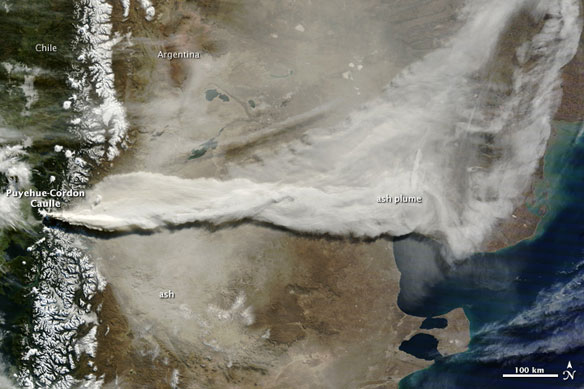
Image source: NASA, Jeff Schmaltz, acquired June 13, 2011
By Holli Riebeek, NASA Earth observatory
The Puyehue-Cordón volcano in Chile continues to spew ash that is still disrupting travel as far as Australia and New Zealand this week. A new animation of satellite imagery just released from the NASA/NOAA GOES Project shows the ash spewing from the volcano.
Perhaps the greatest danger posed by the erupting Puyehue-Cordón Puyehue-Cordón Volcano Complex in Chile is the thick layer of ash being deposited east of the volcano. This image, taken on June 13, 2011, by the Moderate Resolution Imaging Spectroradiometer (MODIS) on the Terra satellite, shows ash on the ground and a large plume streaming east from the volcano.
The pale tan coating of ash on the ground has been accumulating since June 4, when the eruption started. The Chilean Service of Minerals and Mining (SERNAGEOMIN) warned that when winter rains begin to fall in the coming weeks, the loose ash could create dangerous landslides and lahars, particularly in ash-clogged river valleys in the Andes Mountains.
The image above also shows a large plume of volcanic ash blowing about 800 kilometers east and then northeast over Argentina. The plume has disrupted air traffic as far away as New Zealand.
Though the intensity of the eruption has decreased slightly, volcanic activity is holding steady. The plume reached between 4 and 8 kilometers in altitude on June 13, its height varying with the intensity of the eruption throughout the day.









